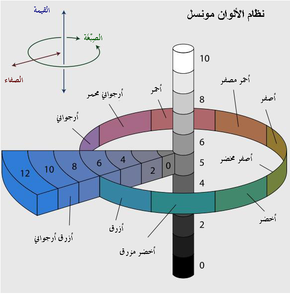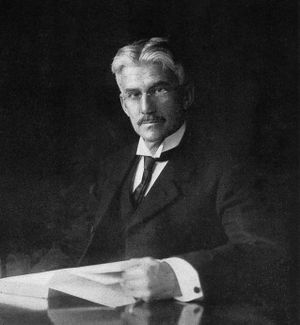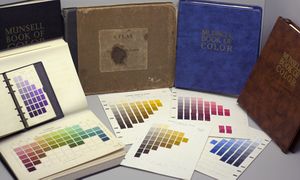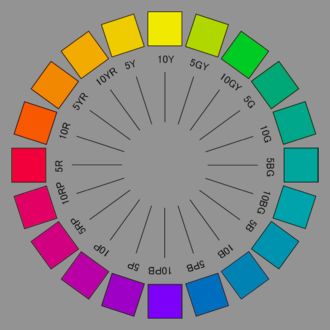نظام الألوان مونسل

نظام الألوان مونسل إنگليزية: Munsell color system : في علم قياس اللون، فإن نظام الألوان مونسل هو فضاء لوني يحدد الألوان اعتمادا على ثلاث أبعاد لونية: صبغة اللون، قيمة اللون ()، وصفاء اللون. وقد وضعه ألبرت هنري مونسل في العقد الأول من القرن العشرين.
أنظمة الألوان التي سبقت نظام الألوان مونسل وضعت الألوان في مجسم للألوان ثلاثي الأبعاد وبأشكال مختلفة، ولكن مونسل كان أول من فصل صبغة وقيمة وصفاء اللون في إتساق إدراكي (perceptual uniformity) وأبعاد مستقلة، وكان أول وضح الألوان في فضاء ثلاثي الأبعاد. [1] نظام مونسل، وخصوصا آخر ترميز له، يعتمد على قياسات صارمة للاستجابة البصرية البشرية للون، واضعا إياها في إطار علمي تجريبي. وبسبب اعتماد النظام على الإدراك البصري البشري، فقد صمد في وجد أنظمة الألوان الحديثة، ومع أنه استبدل في بعض الاستخدامات بأنظمة ألوان أخرى مثل CIELAB(L*a*b) و نظام CIECAM02 فإنه بقي واسع الاستخدام حتى وقتنا الحاضر. [2]
. . . . . . . . . . . . . . . . . . . . . . . . . . . . . . . . . . . . . . . . . . . . . . . . . . . . . . . . . . . . . . . . . . . . . . . . . . . . . . . . . . . . . . . . . . . . . . . . . . . . . . . . . . . . . . . . . . . . . . . . . . . . . . . . . . . . . . . . . . . . . . . . . . . . . . . . . . . . . . . . . . . . . . . .
الشرح
يتألف النظام من ثلاثة أبعاد مستقلة يمكن تمثيلها اسطوانيا بمجسم ألوان ثلاثي الأبعاد غير منتظم: الصِبغة، وتقاس بالدرجات في الدوائر الأفقية. صفاء اللون، وتقاس قطريا من المركز إلى الخارج بدءا من المحور الشاقولي ذي اللون الرمادي الحيادي. قيمة اللون، تقاس شاقوليا من 0 (الأسود) إلى 10 (الأبيض).
حدد مونسل توزع الألوان على طول الأبعاد السابقة بأخذ أبعاد قياسات الاستجابة البصرية البشرية. في كل من هذه الأبعاد، كانت ألوان مونسل التي صنعها قريبة من perceptually uniform بحيث جعلت الشكل الناتج غير منتظم إلى حد بعيد. وقد شرح مونسل ما يلي:
صِبغة اللون
تقسم كل دائرة في نظام مونسل إلى خمسة صبغات أساسية: الأحمر Red، والأصفر Yellow، الأخضر Green، الأزرق Blue، الأرجواني Purple، مع خمسة صبغات متوسطة بين الصبغات الأساسية المجاورة [4]. تقسم هذه الدرجات العشرة إلى 10 درجات فرعية، إذن يصبح لدينا 100 صبغة كعدد صحيح. اللونان المتوضعان على طرفي دائرة الصبغة يكون لهما نفس قيمة وصفاء اللون وتسمى بالألوان المتتامة، وتمزج وفق نظام اللون الجمعي مع الرمادي الحيادي ذو القيمة اللونية نفسها. يظهر الشكل في الأسفل أربعين من صبغات مونسل موزعة بانتظام، مع متمماتها الموزعة شاقوليا. قالب:صبغات مونسل
قيمة اللون
تتفاوت قيمة اللون أو إشراق اللون (lightness) على طول مجسم الألوان، من الأسود (قيمة 0) في الأسفل إلى الأبيض (قيمة 10) في الأعلى. [5] تتوضع الألوان الرمادية الحيادية على طول المحور الشاقولي بين الأسود والأبيض.
وقبل مونسل، رسمت مجسمات الألوان العديدة الإضاءة من الأسود في الأسفل إلى الأبيض في الأعلى، مع تدرجات رمادية بينهما، ولكن أهملت هذه النظم ثبات الإشراق الإدراكي بين الشرائح الأفقية. وبدلا من ذلك رسموا لونا أصفرا مشبع بشدة، وأزرق مشبع بشدة، وأرجواني (عاتم) على طول القطر.
صفاء اللون
صفاء اللون إنگليزية: Chroma ويمثل نقاء اللون، ويقاس صفاء اللون قطريا من مركز كل شريحة، وكلما كانت قيمة صفاء اللون أقل، كان اللون أقل نقاءا (باهتا أكثر، كما في الألوان الفاتحة). [6]
لاحظ عدم وجود حدود عليا حقيقية لصفاء اللون. مناطق مختلفة من الفضاء اللوني لها إحداثيات أعظمية مختلفة لصفاء اللون. مثلا، الألوان الصفراء الفاتحة لها صفاء أكثر من الألوان الأرجوانية الفاتحة، بسبب طبيعة العين وفيزياء المحفزات اللونية. يؤدي هذا إلى نطاق واسع من مستويات الصفاء اللوني الممكنة – حتى المستوى 30 لبعض الصِبغات – مع القيمة اللونية (لذلك من الصعب أو من المستحيل صنع أجسام مادية ملونة ذات صفاء لوني عالي، ولا يمكن إعادة تصنيعها في بعض شاشات الحاسوب الحالية).
| لاحظ أن كتاب مونسل للون تحتوي عينات ألوان أكثر من هذا المخطط لكلا 5PB و 5Y (خصوصا الألوان الصفراء الفاتحة، حتى 5Y 9/20، وهذا أكثر بمرتين 5Y 8/10 المربع على اليسار)، وهذه الألوان غير قابلة لإعادة التصنيع في الفضاء اللوني sRGB، لأنه محدود السلسلة اللونية المصممة لمطابقة الإظهار في الرائي والحاسوب. | ||||||||||||||||||||||||||||||||||||||||||||||||||||||||||||||||||||||||||||||||||||||||||||||||||||||||||||||||||||||||||||||||||||||||||||||||||||||||||||||||||||||||
. . . . . . . . . . . . . . . . . . . . . . . . . . . . . . . . . . . . . . . . . . . . . . . . . . . . . . . . . . . . . . . . . . . . . . . . . . . . . . . . . . . . . . . . . . . . . . . . . . . . . . . . . . . . . . . . . . . . . . . . . . . . . . . . . . . . . . . . . . . . . . . . . . . . . . . . . . . . . . . . . . . . . . . .
تحديد لون
5P 5/10
A color is fully specified by listing the three numbers for hue, value, and chroma in that order. For instance, a purple of medium lightness and fairly saturated would be 5P 5/10 with 5P meaning the color in the middle of the purple hue band, 5/ meaning medium value (lightness), and a chroma of 10 (see the swatch to the right).
التاريخ والمؤثرات


فكرة استخدام جاسئ الألوان ثلاثي الأبعاد لتمثيل كل الألوان تم تطويرها أثناء القرنين 18 و 19. اُقتـُرحت أشكال مختلفة متعددة لذلك الجاسئ، منها: هرم مثلثي مزدوج من توبياس ماير في 1758، هرم مثلثي مفرد من يوهان هاينريش لامبرت في 1772، وكرة من فيليپ اوتو رونگه في 1810، نصف كرة من ميشل أوجين شڤرول في 1839، وقمع من هرمان فون هلمهولتس في 1860، مكعب مائل من وليام بنسون[بحاجة لتوضيح] في 1868، وقمع مزدوج مقطوع بميل من أوگوست كيرشمان في 1895.[7] تلك الأنظمة أصبحت مع مرور الوقت أكثر تقدماً وتعقيداً، with Kirschmann’s even recognizing the difference in value between bright colors of different hues. But all of them remained either purely theoretical or encountered practical problems in accommodating all colors. بل فوق ذلك، فلم تُبن واحدة منهن على أي قياسات علمية دقيقة للابصار البشري؛ قبل مونسل، العقلاقة بين hue, value, and chroma لم تكن مفهومة.[7]
المراجع
ببليوگرافيا
- Cleland, Thomas M. (1921). A practical description of the Munsell color system, with suggestions for its use. Boston: Munsell Color Company. One of the first books about the Munsell color system, explaining the intuition behind its three dimensions, and suggesting possible uses of the system in picking color combinations. An edited version can be found at http://www.applepainter.com/.
- Kuehni, Rolf G. (2002). "The early development of the Munsell system". Color Research and Application. 27 (1): 20–27. doi:10.1002/col.10002.
{{cite journal}}: Invalid|ref=harv(help); Unknown parameter|curly=ignored (help); Unknown parameter|month=ignored (help) A description of color systems leading up to Munsell’s, and a biographical explanation of Munsell’s changing ideas about color and development of his color solid, leading up to the publication of A Color Notation in 1905. - Landa, Edward R. (September–October 2005). "Charting Color from the Eye of the Beholder". American Scientist. 93 (5): 436–443. doi:10.1511/2005.5.436.
{{cite journal}}: Invalid|ref=harv(help); Unknown parameter|coauthors=ignored (|author=suggested) (help); Unknown parameter|curly=ignored (help)CS1 maint: date and year (link)[dead link] An introductory explanation of the development and influence of the Munsell system. - MacEvoy, Bruce (2005-08-01). "Modern Color Models – Munsell Color System". Color Vision. Retrieved 2007-04-16. A concise introduction to the Munsell color system, on a web page which also discusses several other color systems, putting the Munsell system in its historical context.
- Munsell, Albert H. (1905). A Color Notation. Boston: G. H. Ellis Co.. Archived from the original. You must specify the date the archive was made using the
|archivedate=parameter. http://books.google.com/?id=PgcCAAAAYAAJ Munsell’s original description of his system. A Color Notation was published before he had established the irregular shape of a perceptual color solid, so it describes colors positioned in a sphere. - Munsell, Albert H. (1912). "A Pigment Color System and Notation". The American Journal of Psychology. University of Illinois Press. 23 (2): 236–244. doi:10.2307/1412843. JSTOR 1412843.
{{cite journal}}: Invalid|ref=harv(help); Unknown parameter|curly=ignored (help); Unknown parameter|month=ignored (help) Munsell’s description of his color system, from a lecture to the American Psychological Association. - Nickerson, Dorothy (1976). "History of the Munsell color system, company, and foundation". Color Research and Application. 1 (1): 7–10.
{{cite journal}}: Invalid|ref=harv(help); Unknown parameter|curly=ignored (help)
. . . . . . . . . . . . . . . . . . . . . . . . . . . . . . . . . . . . . . . . . . . . . . . . . . . . . . . . . . . . . . . . . . . . . . . . . . . . . . . . . . . . . . . . . . . . . . . . . . . . . . . . . . . . . . . . . . . . . . . . . . . . . . . . . . . . . . . . . . . . . . . . . . . . . . . . . . . . . . . . . . . . . . . .
وصلات خارجية
- Munsell Color Products, from X-Rite, current owners of the Munsell Color Company.
- Munsell to L*a*b* Conversion Freeware, a Windows application for converting Munsell renotations to CIELAB coordinates.
- Munsell Color Science Laboratory at the Rochester Institute of Technology, an academic laboratory dedicated to color science, endowed by the Munsell Foundation.
- Munsell renotation data in plain text format (from the 1940s Optical Society of America renotations).
- ApplePainter.com, a site explaining the Munsell color chart, including an edited version of Cleland’s book, A practical description of the Munsell color system.
- An explanation of the Munsell system at Adobe.com. Retrieved 13 August 2003
- A brief explanation at the site of the Japanese company Dainichiseika Color & Chemicals, including a nice diagram of the Munsell color solid.
- A flash-based Munsell Palette color-picker from web-design firm Triplecode (based on a version originally created at the MIT Media Lab).
- ToyPalette from Loo & Cox, a web application for generating color palettes from images. Munsell color analysis of digital image.



